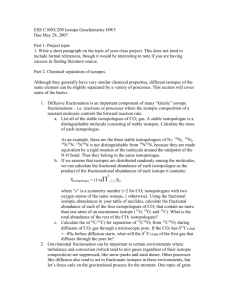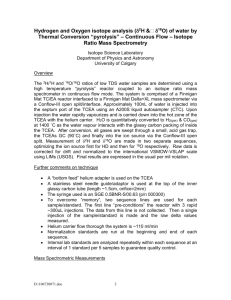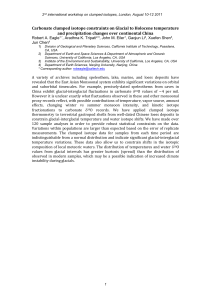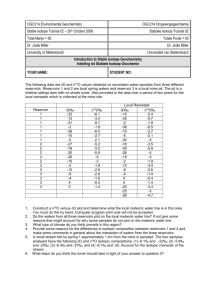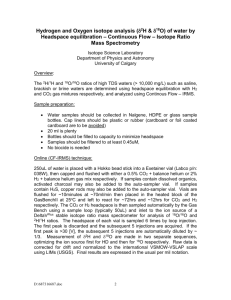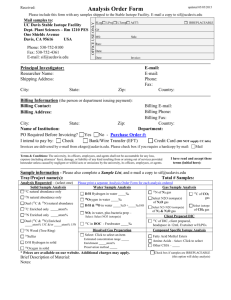CB10078silco2
advertisement
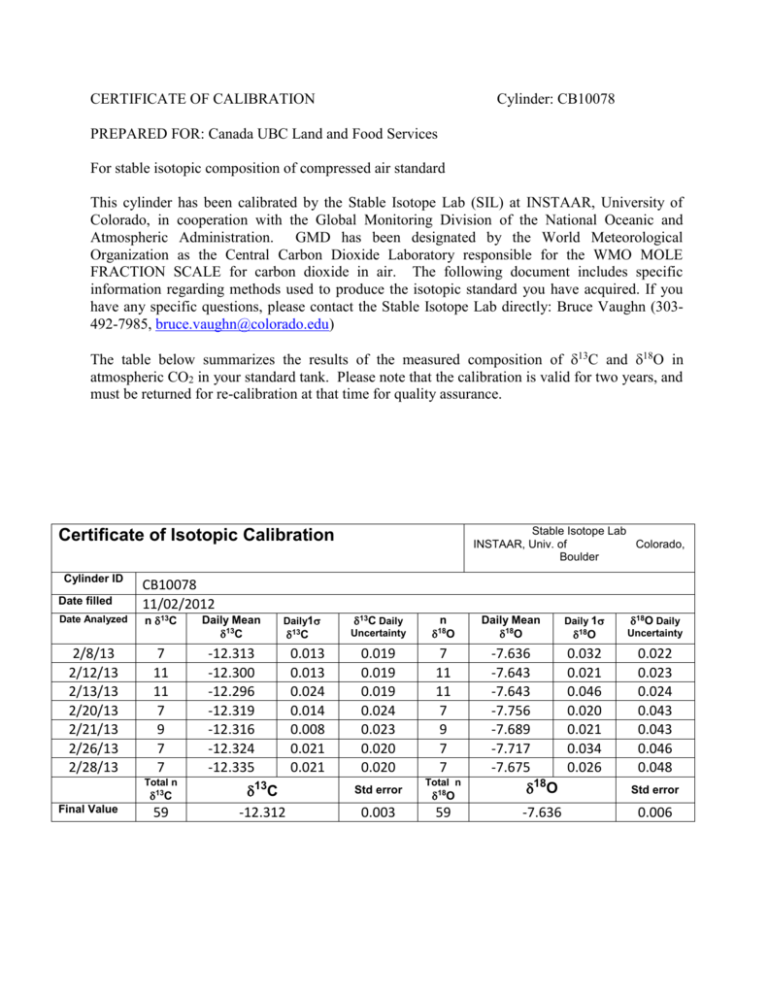
CERTIFICATE OF CALIBRATION Cylinder: CB10078 PREPARED FOR: Canada UBC Land and Food Services For stable isotopic composition of compressed air standard This cylinder has been calibrated by the Stable Isotope Lab (SIL) at INSTAAR, University of Colorado, in cooperation with the Global Monitoring Division of the National Oceanic and Atmospheric Administration. GMD has been designated by the World Meteorological Organization as the Central Carbon Dioxide Laboratory responsible for the WMO MOLE FRACTION SCALE for carbon dioxide in air. The following document includes specific information regarding methods used to produce the isotopic standard you have acquired. If you have any specific questions, please contact the Stable Isotope Lab directly: Bruce Vaughn (303492-7985, bruce.vaughn@colorado.edu) The table below summarizes the results of the measured composition of 13C and 18O in atmospheric CO2 in your standard tank. Please note that the calibration is valid for two years, and must be returned for re-calibration at that time for quality assurance. Stable Isotope Lab INSTAAR, Univ. of Colorado, Boulder Certificate of Isotopic Calibration Cylinder ID Date filled Date Analyzed 2/8/13 2/12/13 2/13/13 2/20/13 2/21/13 2/26/13 2/28/13 CB10078 11/02/2012 n 13C 7 11 11 7 9 7 7 Total n 13C Final Value 59 Daily Mean 13C Daily1 -12.313 -12.300 -12.296 -12.319 -12.316 -12.324 -12.335 0.013 0.013 0.024 0.014 0.008 0.021 0.021 13C 13C -12.312 13C Daily Uncertainty 18O 0.019 0.019 0.019 0.024 0.023 0.020 0.020 7 11 11 7 9 7 7 Std error 0.003 n Total n 18O 59 Daily Mean 18O -7.636 -7.643 -7.643 -7.756 -7.689 -7.717 -7.675 18O -7.636 18O 18O Daily Uncertainty 0.032 0.021 0.046 0.020 0.021 0.034 0.026 0.022 0.023 0.024 0.043 0.043 0.046 0.048 Daily 1 Std error 0.006 Background Information for Stable Isotopes and Standards The stable isotopes of carbon and oxygen in CO2 extracted from the standard cylinder air have been analyzed at the Stable Isotope Laboratory at CU-INSTAAR in Boulder, Colorado, using a Micromass Optima dual inlet isotope-ratio mass spectrometer. The details of our methodologies can be found in Trolier et al. 1996, as well as on our web site: http://instaar.colorado.edu/sil/ and on the NOAA ESRL/GMD ftp data server: ftp://ftp.cmdl.noaa.gov/ccg/co2c13/flask/README_flask_co2c13.html Notation and scale: The isotope data are reported as 'delta' values relative to a standard, in units of 'per mil' (parts per thousand). The 'delta' notation is (for 13C for example): 13C = [ (13C/12C) sample / (13C/12C) reference - 1 ] x 1000 For carbon and oxygen isotopes, the reference is VPDB-CO2 (Coplen 1995). The current scale at SIL was set using NBS-19 and NBS-20 (carbonates) and VSMOW, GISP and SLAP (waters). Method: Air from the tank is released by a single stage regulator at 10 psig (see more on regulators below) and is admitted to a manifold through stainless steel tubing. The air is pulled with vacuum through a mass flow controller set at 40 sccm into a beaded glass water trap at -80° C to remove water vapor, and then through a ‘U’ trap chilled to liquid nitrogen temperatures (-196° C) where the CO2 is frozen out. Any non-condensable gases are removed with several minutes of high vacuum while the sample is frozen. The sample is subsequently warmed and expanded into the sample bellows where it can be adjusted to match the pressure of the running gas held in the reference bellows. Each aliquot of CO2 is alternately fed into the analyzer, and the resultant beams are bellows-balanced to 5e-9 amps. The reference and sample gases are switched for 12 cycles and beams are integrated for 20 seconds after a short delay for stability. The final results are averaged into ratios of beam currents from the multiple ref/sam switches, and stored for later computations to proper scales and delta values (Trolier et al. 1996). CO2 in air extracted from a calibrated tank standard are analyzed in the same run, before and after the unknowns. A separate standard cylinder (a quality assurance or ‘trap tank’) is analyzed as an additional performance diagnostic and as a check against any potential drift in standards. By extracting our trap, standard, and reference bellows CO2 through the exact same system as each sample, we follow the identical treatment principle. This principle is promoted in order to achieve greater accuracy in our reported delta values through the maintenance of long-term standard performance (Werner and Brand 2000). Measurement Corrections: Since the ion beam currents are measured for masses of 44, 45, and 46 corresponding to the 12C, 13 C and 18O isotopes, respectively, mathematical corrections are needed to account for other molecules of similar masses that are erroneously included in these measurements. N2O also shares the masses 44 (NNO), 45 (15NOO), and 46 (N18O), and since N2O freezes along with CO2 in the liquid nitrogen trap, a negative offset of 0.21 ± 0.01‰ for δ13C and 0.30 ± 0.01‰ for δ18O is corrected for in our post-analysis processing (Sirignano et al. 2004). Please refer to Mook W.G. & Jongsma J. 1987 for more information on the correction algorithm. Other isotopomers that interfere with our raw delta values include 12C16O17O, which affects mass 45, and 13C17O16O and 12C17O17O affecting mass 46. To correct for 17O, an algorithm is used that incorporates 17R and 13R (the 17O /16O ratio and 13C/12C ratio of VPDB) and a lambda value, which relates differences in 17O and 18O abundances (Brand, Assonov, and Coplen, 2009). A new understanding of the behavior of atmospheric CO2 and how it relates to the world water cycle has led to the new and improved lambda value of 0.528 set by Assonov and Brenninkmeijer 2003a, 2003b. They also redetermined the absolute value of 17RVPDB-CO2 and proposed a new correction algorithm. The 13th WMO/IAEA experts meeting in 2009 officially recommended the exclusive use of this algorithm and conjoining constants. However, the calculation was difficult to solve, but was recently simplified by the linear approximation formula provided by Brand, Assonov, and Coplen (2009). They also made a slight adjustment of 17R. Therefore, all values reported are determined using the 17R value and correction suggested by Brand, Coplen, and Assonov (2009) and the lambda value set by Assonov and Brenninkmeijer (2003a). Determination of isotopic standards The procedure for calibrating tanks is to analyze at least three sets of five extractions that are performed over a period of several months. Typically, the first values from a newly filled tank are rejected. The precisions for 13C and 18O quoted with your tank are standard errors calculated from these analyses. The value reported is the unweighted mean. Daily instrument runs include measurements from a cylinder whose isotope value is known: this "trap" tank alerts us to any problems with the mass spectrometer or extraction system. We also use this cylinder to calculate uncertainty, which we define as the standard deviation of ten runs' worth of trap measurements. Usually four trap samples are run per day, of which all but the first are used (due to known irregularities caused by the tank regulator). For each run, the uncertainty is calculated from the trap data from that run, regardless of its flagging, and the previous nine runs of unflagged data. (For example, if the current run is flagged, that trap data will be used in the uncertainty calculation; however, the next day's run will not use the flagged data in its uncertainty calculation. Presumably, whatever caused one run to be flagged will have been repaired.) As of November 2010, uncertainty is calculated with each run, and has been back-calculated to 2004. On the Optima (flask measurement system) uncertainty averages 0.014‰ for 13C and 0.035‰ for 18O; for the Isoprime (PFP system), uncertainty averages 0.017‰ for 13C and 0.04‰ for 18O. Post-processing of the data ties the analyzed values to long-term air standards, which are tied to the VPDB-CO2 scale. The Stable Isotope Lab at INSTAAR maintains a minimum of 16 different tank-standards as a hierarchy of isotopic reference materials. Four tanks are analyzed every 6 months; 4 are analyzed monthly; and 8 are kept as rotating daily standards. The absolute value of the 13C scale (accuracy) can only be as good as the determinations of NBS-19 carbonates, which have historically been ±0.03 ‰. If you have multiple tanks, the relative intracalibration of these is typically much better, at least ±0.01‰. All tank standards are linked to other labs via the inter-calibration of 6 “CLASSIC” cylinders that rotate through 4 different isotope labs through out the world: A) Commonwealth Scientific and Industrial Research Organization - Atmospheric Research, (CSIRO) Aspendale, Victoria, Australia; B) Institute of Arctic and Alpine Research, (INSTAAR) University of Colorado, Boulder, Colorado, USA & National Oceanic and Atmospheric Administration Global Monitoring Division, (GMD) Boulder, Colorado, USA; C) Scripps Institution of Oceanography, University of California, (SIO ) San Diego, California, USA; and D) Center for Atmospheric and Oceanic Studies, Tohoku University, Sendai, Japan (TU). The accuracy of 18O of atmospheric CO2 measurements is limited by the precision of 18O determinations of waters, which is typically ±0.06 ‰. However, inter-comparisons with other laboratories (noted above) of 18O measured on CO2 extracted from air suggests that there may be scale offsets (possibly as much as 1 per mil) between the various laboratories' independently calibrated scales. Ongoing intercomparison experiments among laboratories making these measurements is essential for assessing the comparability of isotope measurements from one lab with another. The INSTAAR-NOAA scale was known to be +0.82 per mil different from other labs measuring the d18O of CO2 in air (Masarie et al., 2001; Allison et al.,2003). The application of a +0.82 per mil scale adjustment has been made as of November 2006 as a result of comparisons, including the CLASSIC cylinders; standards prepared by Hitoshi Mukai's NARCIS I and II; CO2 in air samples from W. Brand; Flask inter comparisons with CSIRO (Cape Grim); and IAEA standard materials. More information about this scale shift is available at our web site: ftp://ftp.cmdl.noaa.gov/ccg/co2o18/flask/README_flask_co2o18.html Also, for reasons not entirely understood, measurements of 18O in atmospheric CO2 from standard cylinders are occasionally subject to drift and instability. It is not unusual for any tank to experience initial drift in 18O values, but these should stabilize and plateau. The plateau value is reported with your cylinder. Important note on regulators: There are known isotopic problems with some types of high-pressure regulators used for the cylinders. Lower cost models that have seals made with elastomers such as Viton or butyl rubber are particularly problematic. These materials can contaminate the standard air with compounds that contribute to masses 45 and 46. We recommend using a high purity regulator that has a minimum of non-metallic surfaces, preferably stainless steel. We have chosen for use on all our standards the Air Products model E11-C444A (CGA-590) stainless steel single stage regulator with Kel-F and Teflon seals. It has proven to be a more stable regulator. Single stage regulators may lack the long-term pressure stability that can be found with two stage regulators, but since very little gas is used in the analysis process for even our daily standards, the necessary adjustments of outlet pressure are infrequent. The single stage model also has the advantage of fewer wetted parts and is more economical (~approx. $550 US). No doubt there are likely other brands of regulators that would also perform adequately, but are untested by our analysis process. References Allison, C.E, R.J. Francey, and L.P. Steele, The International Atomic Energy Agency Circulation of Laboratory Air Standards for Stable Isotope Comparisons: aims, preparation, and preliminary results, IAEA-TECDOC-1269 (2002). Assonov, Sergey S. and Carl A.M. Brenninkmeijer, A redetermination of absolute values for 17Rvpb-co2 and 17Rvsmow, Rapid Communications in Mass Spectrometry 17: 1017-1029 (2003). Brand, Willi A., Sergey S. Assonov, and Tyler B. Coplen, Correction for the 17O interference in d13C measurements when analyzing CO2 with stable isotope mass spectrometry, IUPAC (2009). Ciais, P., P.P. Tans, J.W.C. White, M. Trolier, R.J. Francey, J.A. Berry, D.R. Randall, R.J. Sellers, J.G. Collatz and D.S. Schimel, Partitioning of ocean and land uptake of CO2 as inferred by d13C measurements from the NOAA/CMDL global air sampling network, JGR 100, 5051-5070 (1995). Ciais, P., P.P. Tans, M. Trolier, J.W.C. White and R.J. Francey. A large northern hemisphere terrestrial CO2 sink indicated by the 13C/12C ratio of atmospheric CO2, Science 269, 1098-1102 (1995). Ciais, P., A.S. Denning, P.P. Tans, J.A. Berry, D.A. Randall, G.J. Collatz, P.J. Sellers, J.W.C. White, M. Trolier, H.A.J. Meyer, R.J./ Francey, P. Monfray, and M. Heimann, A three-dimensional synthesis study of d18O in atmospheric CO2. 1. Surface fluxes, J. Geophys. Res. 102, 5857-5872, 1997. Ciais, P., P.P. Tans, A.S. Denning, R.J. Francey, M. Trolier, H.A.J. Meyer, J.W.C. White, J.A. Berry, D.A. Randall, G.J. Collatz, P.J. Sellers, P. Monfray, and M. Heimann, A three-dimensional synthesis study of d18O in atmospheric CO2. 2. Simulations with the TM2 transport model, J. Geophys. Res. 102, 5873-5883, 1997. Coplen, T.B., 1995, Reporting of stable carbon, hydrogen, and oxygen isotopic abundances, in Reference and intercomparison materials for stable isotopes of light elements: Vienna, International Atomic Energy Agency, IAEA-TECDOC-825, p. 31-34. Francey, R.J., P.P. Tans, C.E. Allison, I.G. Enting, J.W.C. White and M. Trolier, Changes in oceanic and terrestrial carbon uptake since 1982,Nature 373, 326-330 (1995). Gemery, P.A., M. Trolier, and J.W.C. White, Oxygen isotope exchange Between carbon dioxide and water following atmospheric sampling using glass flasks,J. Geophsy. Res., 101, 14,415-14, 420, 1996. Trolier, M., J.W.C. White, P.P. Tans, K.A. Masarie and P.A. Gemery, Monitoring the isotopic composition of atmospheric CO2: measurements from the NOAA Global Air Sampling Network, JGR 101, 25,897-25,916 (1996). Werner, Roland A. and Willi A. Brand, Referencing strategies and techniques in stable isotope ratio analysis, Rapid Communications in Mass Spectrometry 15: 501-519 (2000).
